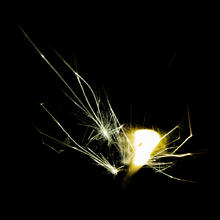Ferrocerium

Ferrocerium is a man-made metallic material that produces hot sparks at temperatures of about 3,000 °C (5,430 °F) when scraped against a rough surface (pyrophoricity), such as ridged steel. Because of this property it is used in many applications, such as clockwork toys, strikers for gas welding and cutting torches, so-called "flint-and-steel" or "flint spark lighter" fire-starters in emergency survival kits and cigarette lighters, as the initial ignition source for the primary fuel.[1] It is also commonly called ferro rod and most commonly of all, flint (particularly in cigarette lighters).
Use

While ferrocerium-and-steels function in a similar way to natural flint-and-steel in fire starting, ferrocerium takes on the role that steel played in traditional methods: when small shavings of it are removed quickly enough the heat generated by friction is enough to ignite those shavings, converting the metal to the oxide, i.e., the sparks are tiny pieces of burning metal. The sparking is due to cerium's low ignition temperature of between 150 and 180 °C (302 and 356 °F). About 700 tons were produced in 2000.
Comparison with natural flint
Modern flint bears no chemical relationship to the mineral flint, the name for two types of rock historically used to generate sparks. In traditional flint-and-steel fire-starting systems (using natural flint), an iron-bearing rock was used, which has a passing resemblance of modern flint, as it is iron in the tiny shards of rock produced in the striking process that burn.
Flint spark lighter
A flint spark lighter (sometimes just called a spark lighter, striker, or flint lighter) is a type of lighter used in many applications to safely light a gaseous fuel to start a flame. It is most commonly used for bunsen burners and oxyacetylene welding torches.
A flint spark lighter works by rapidly rubbing a small piece of ferrocerium upon the sharp edge of any substance that is harder than the rod, However carbon steel works better than most any other material in much the same way flint and steel are used. This manual rubbing action, done by squeezing the handle, creates a spark which then lights the gaseous fuel.
As tinder-igniting campfire starter rods it is sold under such trade names as Blastmatch, Fire Steel and Metal-Match for survivalists and bushcraft hobbyists. Some manufacturers and resellers incorrectly call them "magnesium" rods. However, some manufacturers combine a strip of ferrocerium along with a strip of magnesium in the same item, to be used by scraping off flakes of magnesium and then striking the ferrocerium with a knife. The sparks from the ferrocerium will ignite the magnesium, which will in turn ignite the tinder.
Composition
It is also known in Europe as Auermetall after its inventor Baron Carl Auer von Welsbach. Three different Auermetalls were developed: the first was iron and cerium, the second also included lanthanum to produce brighter sparks, and the third added other heavy metals. In the Baron von Welsbach's first alloy, 30% iron (ferrum) was added to purified cerium, hence the name "ferro-cerium". Iron reacts with rare earth metals to form hard intermetallic compounds similar to those in neodymium magnets; such magnets are known to generate sparks when broken.
A modern ferrocerium firesteel product is composed of an alloy of rare earth metals called mischmetal (containing approximately 50% cerium, 25% lanthanum, and small amounts of praseodymium and neodymium), plus iron and a small amount of magnesium.[2] A variety of other components are added to modify the spark and processing characteristics.[1] Most contemporary flints are hardened with 20% iron oxide and 2% magnesium oxide.
| Element | Iron | Cerium | Lanthanum | Neodymium | Praseodymium | Magnesium |
|---|---|---|---|---|---|---|
| Percentage | 19% | 38% | 22% | 4% | 4% | 4% |
See also
References
- 1 2 Klaus Reinhardt and Herwig Winkler in "Cerium Mischmetal, Cerium Alloys, and Cerium Compounds" in Ullmann's Encyclopedia of Industrial Chemistry 2000, Wiley-VCH, Weinheim. doi:10.1002/14356007.a06_139
- ↑ Cerium flint rod product description
External links
- Jorgenson, John D.; Corathers, Lisa A.; Gambogi, Joseph; Kuck, Peter H.; Magyar, Michael J.; Papp, John F.; Shedd, Kim B. "Minerals Yearbook 2006: Ferroalloys" (PDF). United States Geological Survey. Retrieved 2009-04-24.